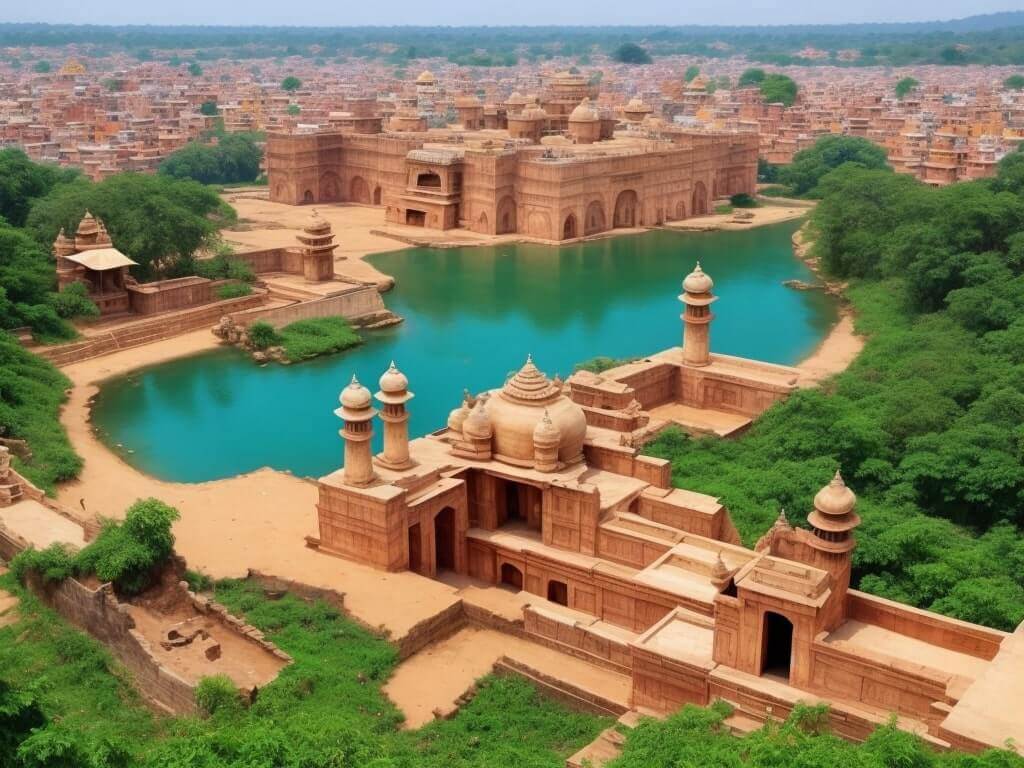Table of Contents
I’ve always been fascinated by the spiritual heart of India, a country that’s not just diverse in its culture but also in its spirituality. One of the most profound spiritual journeys one can embark on in India is visiting the 12 Jyotirlingas. These are not just temples; they’re the abodes of Lord Shiva, where his presence is felt in the form of light, or ‘Jyoti’, hence the name Jyotirlinga.
From Somnath in Gujarat to Rameshwaram in Tamil Nadu, each Jyotirlinga has its own unique legend and significance, drawing devotees and tourists alike. My journey through these sacred temples wasn’t just a trip but a deep dive into the spiritual essence of India. It’s a path that leads you through the scenic beauty of the country, lets you experience the rich tapestry of Indian culture, and, most importantly, brings you closer to the divine.

Check out : Unveiling the Magnificence of the Adiyogi Shiva Statue
Introduction to the 12 Jyotirlingas
Imagine a spiritual network spread across India, each node pulsating with divine energy and wrapped in fascinating legends. That’s what the 12 Jyotirlingas represent. These sacred temples of Lord Shiva are spread from the north to the south and east to west of India, each with a story that’s as captivating as the next.
Places like Pune in Maharashtra, Nashik, and Aurangabad each house a Jyotirlinga, symbolising different avatars and aspects of Lord Shiva. The spiritual significance of these sites is immense, believed to be the places where Shiva appeared as a fiery column of light. The aura and energy at these sites are so powerful that one can’t help but feel a deep sense of peace and divinity.
Each Jyotirlinga, from Somnath in Gujarat to Mallikarjuna in Andhra Pradesh, has its unique architectural marvel and historical richness, making them not just spiritual centres but also hubs of culture and history. The stories behind these shrines are as diverse as India itself, each adding a different flavour to the spiritual journey of a devotee or a curious traveller like me.
Embarking on a journey to visit all 12 Jyotirlingas is like stepping into a world where the divine meets the earthly, where legends come alive, and faith deepens with every step. It’s a pilgrimage that offers a glimpse into the soul of India, its devotion, and its eternal quest for the divine.
Unveiling the Spiritual Essence
Visiting the 12 Jyotirlingas wasn’t just about witnessing the grandeur of these temples or understanding their history; it was about feeling the spiritual essence that pervades these sacred spaces. It’s an experience that’s hard to put into words. Each temple, with its distinct ambiance and rituals, offered a different shade of spirituality, revealing the multifaceted nature of divine worship in India.
The Legend Behind the 12 Jyotirlingas
The legend of the Jyotirlingas is as enchanting as the sites themselves. It’s said that Lord Shiva pierced the three worlds as an infinite pillar of light, and the 12 Jyotirlingas are the places where this light touched the earth. This divine play, or ‘leela’, of Shiva not only marks the victory of light over darkness but also symbolises the omnipresence and the formless nature of the divine.
List Of 12 Jyotirlingas and their Locations
| Jyotirlinga Name | Location | State |
|---|---|---|
| Somnath | Prabhas Patan | Gujarat |
| Mallikarjuna | Srisailam | Andhra Pradesh |
| Mahakaleshwar | Ujjain | Madhya Pradesh |
| Omkareshwar | Mandhata Island | Madhya Pradesh |
| Kedarnath | Kedarnath | Uttarakhand |
| Bhimashankar | Near Pune | Maharashtra |
| Kashi Vishwanath | Varanasi | Uttar Pradesh |
| Trimbakeshwar | Nashik | Maharashtra |
| Vaidyanath | Deoghar | Jharkhand |
| Nageshwar | Daarukavanam | Gujarat |
| Rameshwar | Rameswaram Island | Tamil Nadu |
| Grishneshwar | Ellora | Maharashtra |
12 Jyothirlinga Map
12 Jyotirlingas of India
From the serene hills of Kedarnath to the bustling streets of Varanasi, each Jyotirlinga is a world in itself, offering a unique blend of spiritual and cultural experiences. My journey through these sacred sites was a roller coaster of emotions, filled with moments of awe, peace, and profound devotion. It was a reminder of the rich spiritual heritage of India and the eternal call of the divine.
1. Somnath, Gujarat - The Eternal Shrine
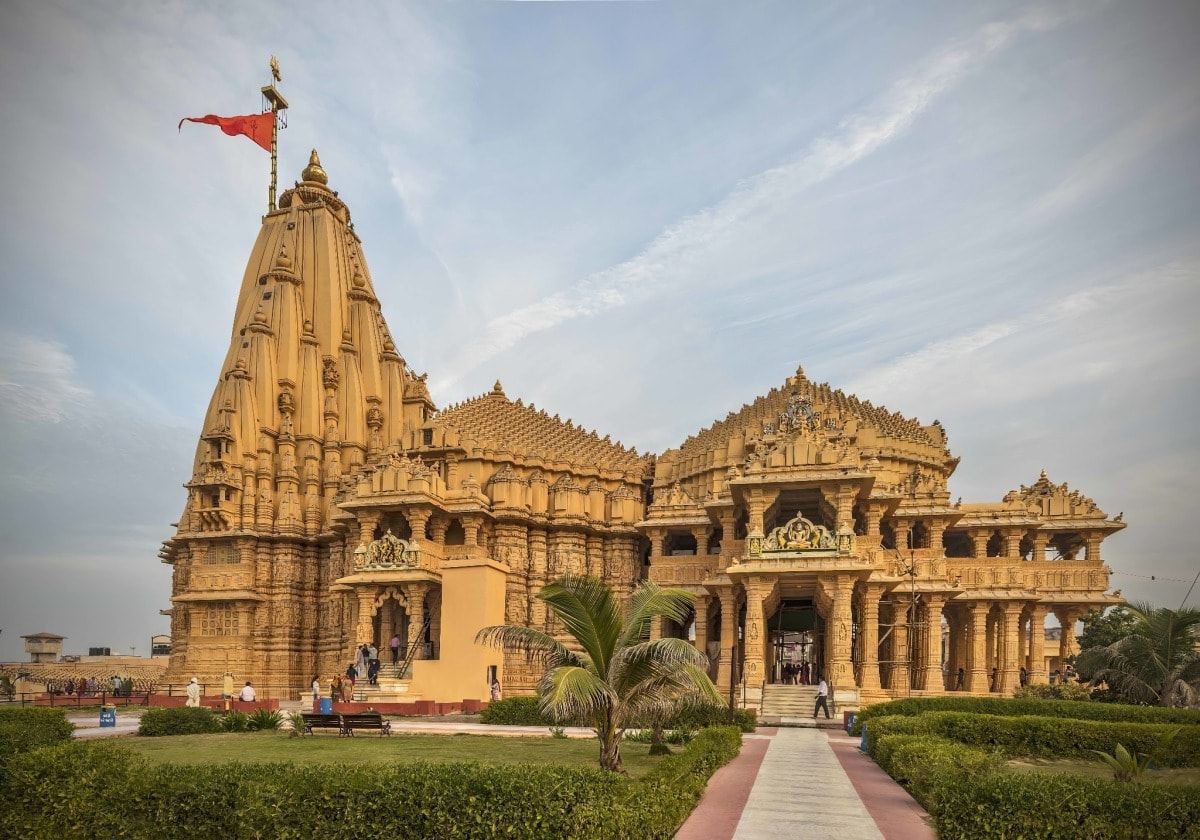
My journey began with Somnath in Gujarat, the first Jyotirlinga. The temple, with its breathtaking architecture and the roaring sea as its backdrop, was a sight to behold. The intricate carvings and the serene ambience of the place filled me with a sense of awe. It's said that this temple has been destroyed and rebuilt several times, a testament to the faith and resilience of the devotees.
The legends and history associated with Somnath are as captivating as the temple itself. According to the Shiv Purana, the moon god was blessed by Lord Shiva at this very spot, giving the temple its name and religious importance. Walking through the temple, amidst the chants and the rhythmic sound of the waves, I felt a deep connection with the divine.
Exploring Somnath wasn't just about the temple; it was about immersing myself in a spiritual aura that encompasses the entire place. The experience was a blend of peace, devotion, and an indescribable energy that stayed with me long after I left.
Architecture and History
The temple architecture of Somnath is a marvel in itself, showcasing the brilliance of ancient Indian craftsmanship. The intricate carvings on the temple walls and the majestic spire that pierces the sky tell a story of devotion, artistry, and the saga of a shrine that has withstood the test of time.
The history of Somnath is a saga of destruction and rebirth. It's said to have been destroyed and rebuilt several times, each reconstruction serving as a symbol of the unbreakable spirit of faith. This history adds a layer of depth to the temple's spiritual aura, making it a site of immense religious importance.
Temple Timings
Visiting hours for Somnath Temple are spread throughout the day, allowing devotees and tourists ample time to soak in the divine vibes. The temple opens its doors early in the morning and closes late in the evening, ensuring that everyone gets a chance to offer their prayers and witness the aarti.
How To Reach
Reaching Somnath is quite straightforward. The nearest railway station is just a few kilometres away, making it accessible for travellers from all over. The well-connected roads and the availability of local transport make the journey to Somnath hassle-free.
Best Times to Visit
The best time to visit Somnath is from October to March, when the weather is pleasant, making it perfect for exploring the temple and its surroundings. This period also hosts several festivals, offering a glimpse into the vibrant cultural fabric of the place.
Nearby Tourist Places
Around Somnath, several tourist places add to the charm of visiting this Jyotirlinga. From beautiful beaches to ancient ruins, the area is dotted with spots that are worth exploring, making the trip to Somnath a holistic experience of spirituality, history, and natural beauty.
2. Nageshwar, Gujarat - The Protector of All
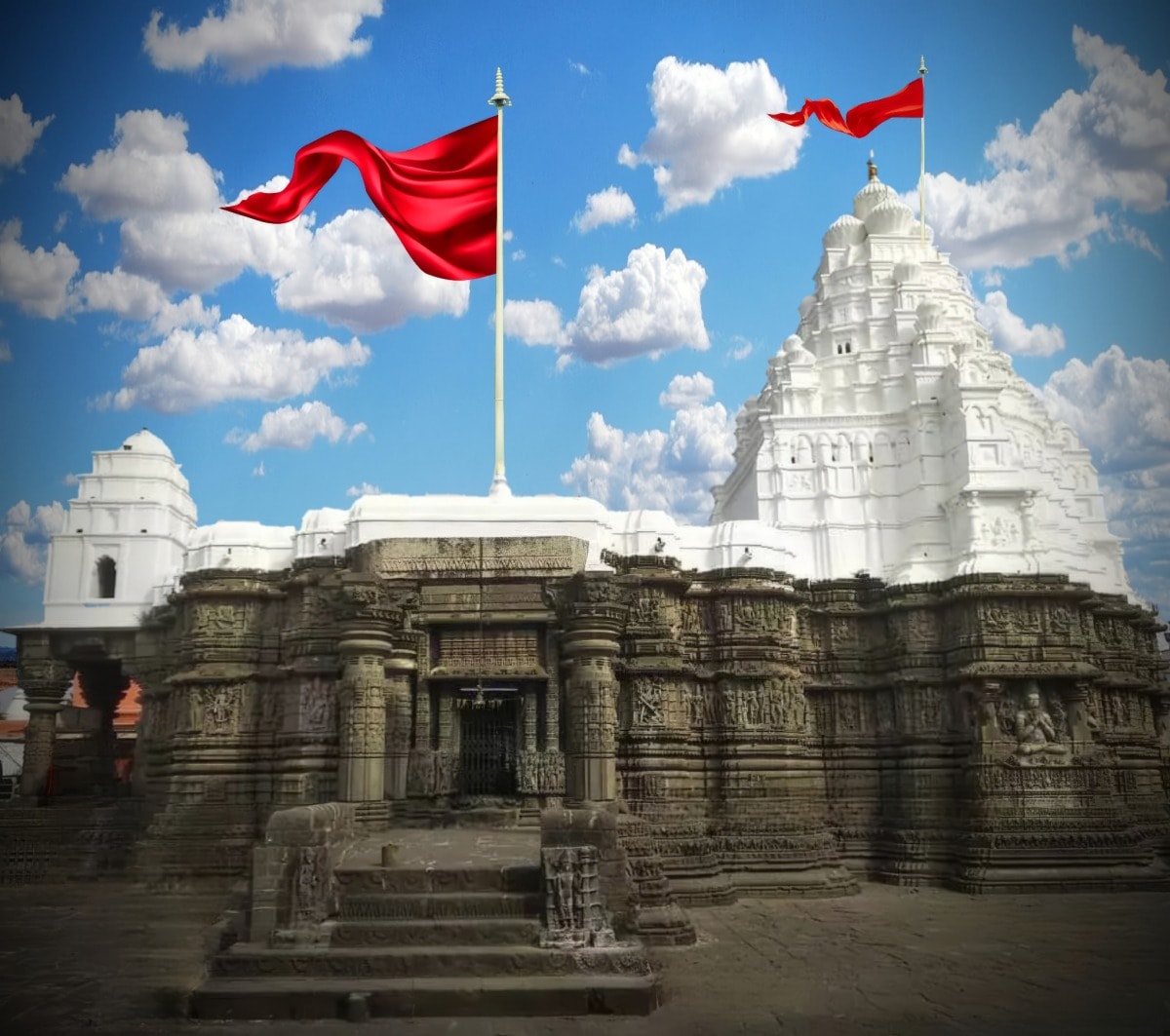
Continuing my journey to Nageshwar, another jewel in Gujarat, I was greeted by the serene aura of the temple, located near the azure Arabian Sea. The massive statue of Lord Shiva dominating the landscape was a sight to behold, embodying the temple's role as a protector against all poisons.
The underground sanctum of Nageshwar, where the Jyotirlinga is housed, felt like stepping into another world. The spiritual energy here was palpable, enveloping me in a blanket of peace and reverence. The temple's location, nestled between the sea and the lush greenery, added to its mystique, making it a place of not just spiritual but also natural beauty.
Visiting Nageshwar was an experience that highlighted the diversity of the Jyotirlingas, each with its unique setting, legend, and spiritual significance. It was a reminder of the all-encompassing nature of the divine, offering protection and blessings to all who seek it.
Architecture and History
The architecture of Nageshwar Temple, with its intricate designs and spiritual symbols, stands as a testament to the ancient artistry and religious devotion of India. The history of the temple, filled with legends and divine interventions, adds a layer of mystique, making it a fascinating site for both devotees and history enthusiasts.
Walking through the temple, I was struck by the sense of timelessness it evoked. The stories of faith and miracles associated with Nageshwar are a powerful reminder of the enduring nature of spiritual belief and the eternal presence of the divine in our lives.
Temple Timings
The temples have their own unique times when they open their doors to devotees. Usually, they're open from early morning until late evening. It's a good idea to check the specific timings of the temple you're planning to visit, as they can vary.
How To Reach
Getting to these sacred spots is part of the adventure. Most of them are accessible by road, and many have a nearest railway station. From there, you can take a taxi or a bus. Some places might be a bit remote, but that's what makes the journey memorable.
Best Times to Visit
The best time to visit these temples is usually during the cooler months, from October to March. This time of the year, the weather is pleasant, making your visit more comfortable and enjoyable. Festivals can also be a great time to visit, though expect more crowds.
Nearby Tourist Places
Around these temples, you'll often find other beautiful places to explore. From scenic viewpoints to historical sites and cultural attractions, there's always something more to see and do. Make sure to plan some extra time to discover these nearby treasures.
3. Bhimashankar, Maharashtra - The Tranquil Sanctuary
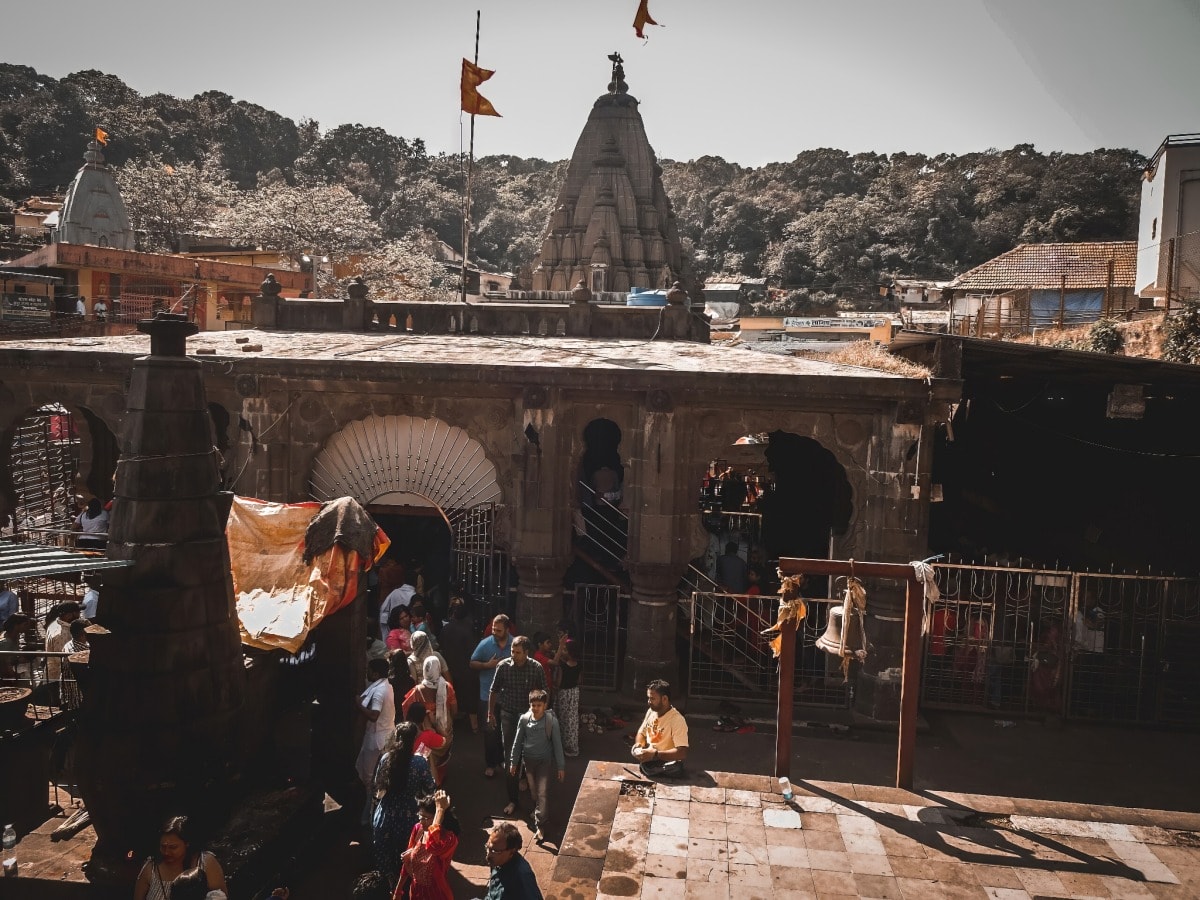
On the banks of the River Bhima, the Bhimashankar temple stands as a magnificent structure made of black rock. It follows the Nagara architectural pattern, which gives it a unique and awe-inspiring look. Surrounded by lush greenery, the temple offers a tranquil escape to all who visit.
The temple is not just a place of worship but also a spot where nature and spirituality blend perfectly. The sound of the river, the chirping of birds, and the serene environment make it a perfect place for meditation and finding peace.
Bhimashankar is also known for its religious significance. It's one of the twelve Jyotirlingas, making it a must-visit for devotees and spiritual seekers. The energy and vibe of the place are said to be incredibly powerful, providing a sense of calm and reverence to everyone who visits.
Architecture and History
The Bhimashankar temple, with its Nagara style of architecture, is a sight to behold. Its intricate carvings and the solid black rock construction tell stories of craftsmanship and devotion. The temple's history is rich, with legends that speak of divine interventions and miracles.
Over the years, the temple has seen renovations and enhancements, but the essence of its ancient design remains untouched. It stands as a testament to the architectural prowess and spiritual depth of India's past.
Temple Timings
The temple welcomes visitors from the early hours of the morning until the sun sets. The best time to visit is during the morning Aarti, which offers a truly divine experience. However, it's advisable to check the latest timings before planning your visit, as they might change.
How To Reach
Bhimashankar is well-connected by road, making it easily accessible for travelers. The nearest railway station is Pune, from where you can hire a cab or take a bus to reach the temple. The journey is as beautiful as the destination, with scenic views along the way.
Best Times to Visit
The temple is best visited during the monsoon and winter months, from June to February. The monsoon brings out the lush greenery of the surrounding area, making it even more picturesque, while the cooler winter months offer a pleasant climate for exploring.
Nearby Tourist Places
Around Bhimashankar, there are several spots worth exploring. From trekking in the nearby hills to visiting the Bhima River, there's plenty to do. The area is also home to a diverse range of flora and fauna, making it a great spot for nature lovers.
4. Trimbakeshwar, Nasik - The Source of the Godavari
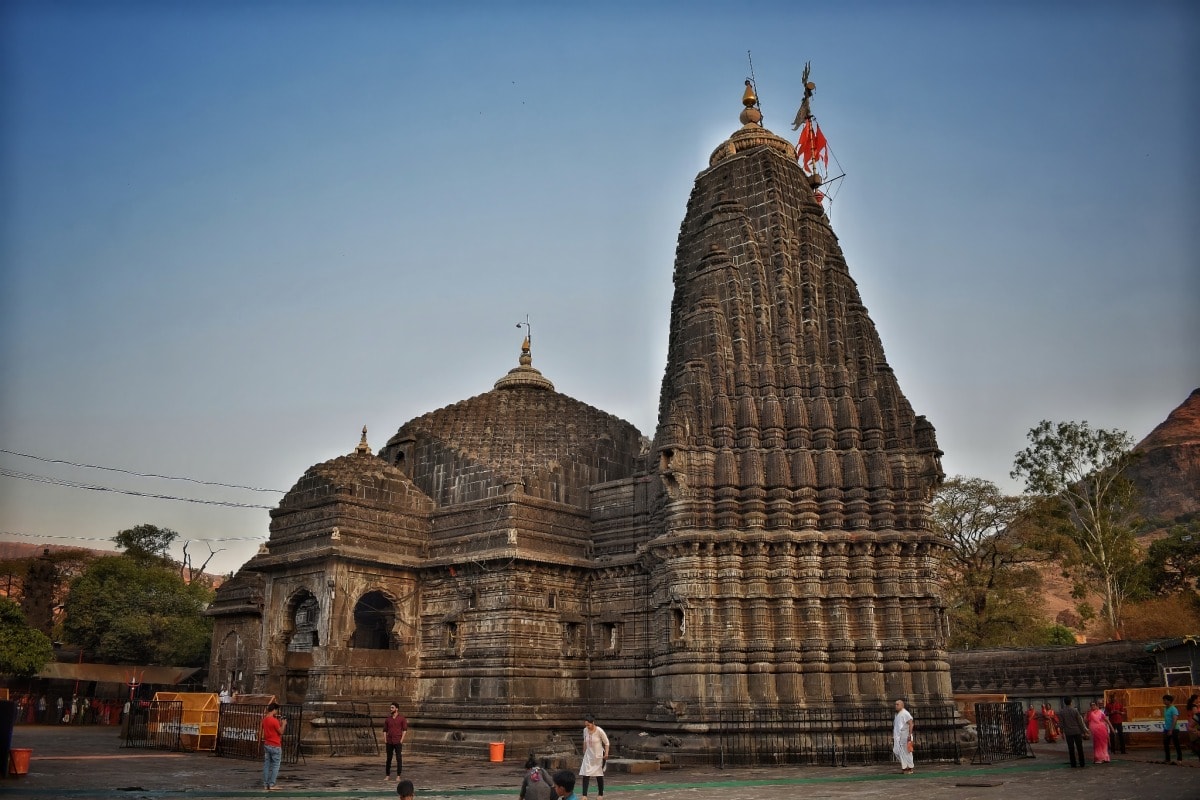
Trimbakeshwar Jyotirlinga, nestled in the picturesque foothills of the Brahmagiri mountains in Nasik, Maharashtra, is a sacred spot dedicated to Lord Shiva. It's one of the revered twelve Jyotirlingas, attracting devotees from all over. The serene environment and the spiritual aura of the place make it a haven for those seeking peace and divinity.
The temple's location by the Godavari's source adds to its sanctity, making it a pivotal site for many religious rituals and ceremonies. The blend of natural beauty and spiritual significance makes Trimbakeshwar a unique pilgrimage, offering a profound experience to all who visit.
Architecture and History
The Trimbakeshwar temple, with its ancient architectural design, stands as a symbol of religious heritage and architectural brilliance. Its construction dates back centuries and showcases the intricate craftsmanship of that era. The temple's structure is a marvel, with detailed carvings and a layout that speaks volumes of the spiritual wisdom of our ancestors.
Over the years, the temple has witnessed numerous historical events and has been a focal point of devotion and faith. Its history is interwoven with legends and lore, making it a fascinating place not just for the devout but also for history enthusiasts.
Temple Timings
The temple opens its doors to devotees early in the morning and closes by evening. The timing for the special Aarti and rituals might vary, so it's always a good idea to check the current timings before visiting. Each visit offers a unique experience, filled with peace and spirituality.
How To Reach
Reaching Trimbakeshwar is convenient, with good road connectivity. The nearest railway station is in Nasik, from where you can easily get a taxi or bus to the temple. The journey is as serene as the destination, with the beautiful Brahmagiri mountain offering stunning views along the way.
Best Times to Visit
The ideal time to visit Trimbakeshwar is from September to March, when the weather is pleasant, making your visit more enjoyable. This period avoids the heavy monsoon rains and the scorching summer heat, providing a comfortable climate for your spiritual journey.
Nearby Tourist Places
When you visit Ghrishneshwar, don't just stop at the temple. There's a whole world to explore around. The Ellora Caves, a UNESCO World Heritage site, are just a stone's throw away. It's a marvelous site, with ancient rock-cut temples that tell tales of a bygone era. Then, there's the formidable Daulatabad Fort, standing tall with its impressive defense mechanisms. For those who love a bit of royal history, the Bibi Ka Maqbara, often referred to as the Mini Taj Mahal of the Deccan, offers a serene and picturesque view. Don't miss these spots; they make your journey even more memorable.
5. Ghrishneshwar, Aurangabad - The Abode of Compassion
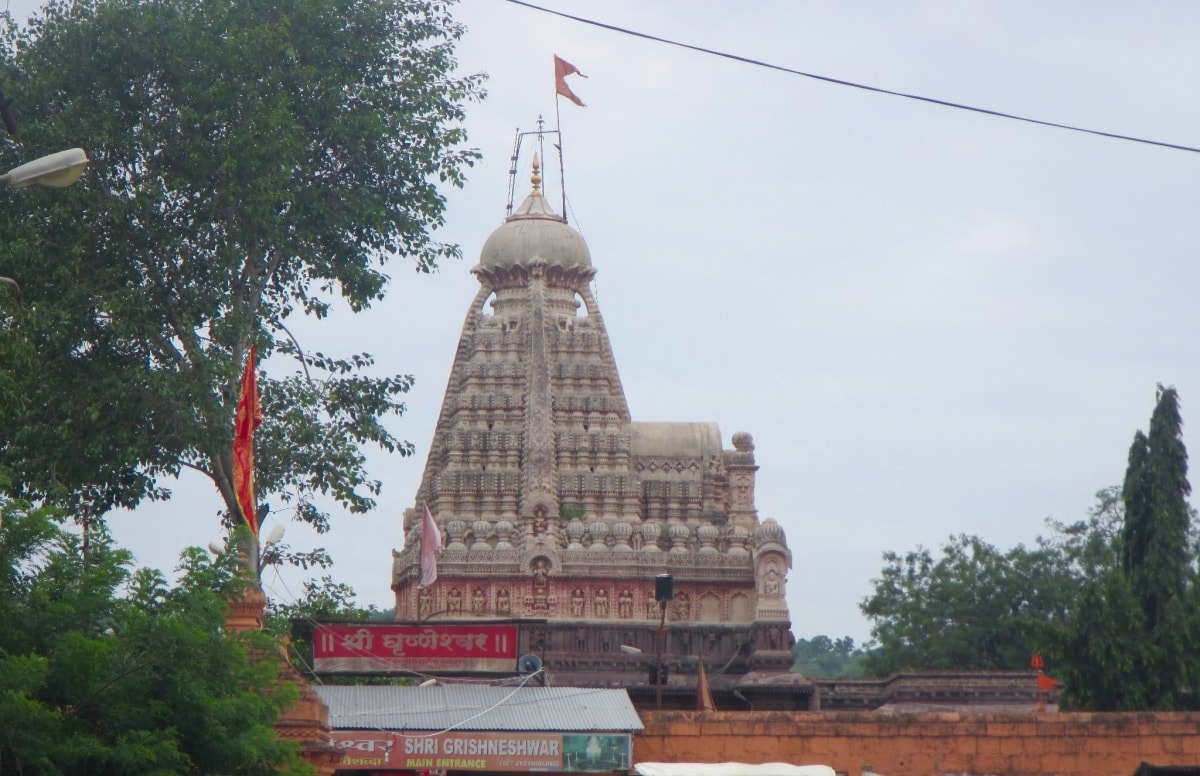
Ghrishneshwar Temple, tucked away near Aurangabad in Maharashtra, holds a special place in my heart. It's not just any temple; it's one of the twelve revered Jyotirlingas dedicated to Lord Shiva. The feeling you get there, it's like nowhere else – a mix of peace, awe, and a deep spiritual connection. What makes it even more special is its location near the Ellora Caves, another marvel that you've got to see to believe.
The legends surrounding this temple are fascinating. It's said that the temple was constructed after a devout woman's prayers were answered by Lord Shiva himself. She wished for a water source for her parched land, and in return, promised to build a temple. The faith and devotion in that story are genuinely moving. It reminds me of the power of belief and how it can bring about miracles.
Walking through the temple, you're surrounded by intricately carved designs and sculptures that are simply breathtaking. The architecture speaks volumes about the skills and devotion of the craftsmen of medieval India. It's these details that make the Ghrishneshwar Temple not just a spiritual retreat but a journey back in time.
Architecture and History
The Ghrishneshwar Temple is a masterpiece of medieval Indian architecture, with every nook and cranny telling a story. The temple showcases intricate carvings and sculptures that depict various legends and stories associated with Lord Shiva. It's said that the temple was constructed out of sheer devotion, and when you see the craftsmanship, you can't help but believe it. The temple's design follows a classic style, with a towering shikara that seems to reach out to the heavens.
The history of the temple is as captivating as its architecture. It has seen centuries pass by, yet it stands firm, offering solace and a sense of belonging to anyone who steps in. The legend of its construction, rooted in a woman's unwavering faith, adds a layer of mystique and devotion to its aura. It's not just a place of worship; it's a monument to the power of belief and the human spirit's resilience.
Temple Timings
The temple opens its doors to visitors early in the morning. You can visit from 5:30 AM to 9:00 PM. I find the mornings especially peaceful, with the first rays of the sun casting a golden glow on the temple, making it feel like you're stepping into a divine realm. It's a good idea to check for any special timings if you're planning to visit during religious festivals, as the temple hosts several rituals and ceremonies that are a sight to behold.
How To Reach
Getting to Ghrishneshwar is quite straightforward. If you're coming from Aurangabad, it's just a short drive away. You can hire a taxi or take a bus that goes directly to the temple. The nearest airport is in Aurangabad, making it convenient for those flying in. For me, the journey to the temple is as memorable as the destination itself, with beautiful landscapes and the anticipation of reaching one of the twelve Jyotirlingas adding to the excitement.
Best Times to Visit
The best time to visit Ghrishneshwar is from October to March. The weather during these months is pleasant, making it ideal for exploring the temple and the surrounding areas without the discomfort of the scorching heat. I particularly love visiting during the Mahashivratri festival when the temple is alive with festivities, and you can really immerse yourself in the spiritual atmosphere.
Nearby Tourist Places
Around Vaidyanath Jyotirlinga in Deoghar, there's much to see and do. The Trikut Pahar, with its cable car ride offering panoramic views, is a must-visit. For those seeking peace, the Tapovan Caves and Tapovan Hill offer a tranquil retreat. History buffs will find the Naulakha Mandir, with its stunning architecture and spiritual ambiance, captivating. Each of these places adds a unique flavour to your trip, making it an experience filled with diverse attractions.
6.Vaidyanath – Deoghar In Jharkhand
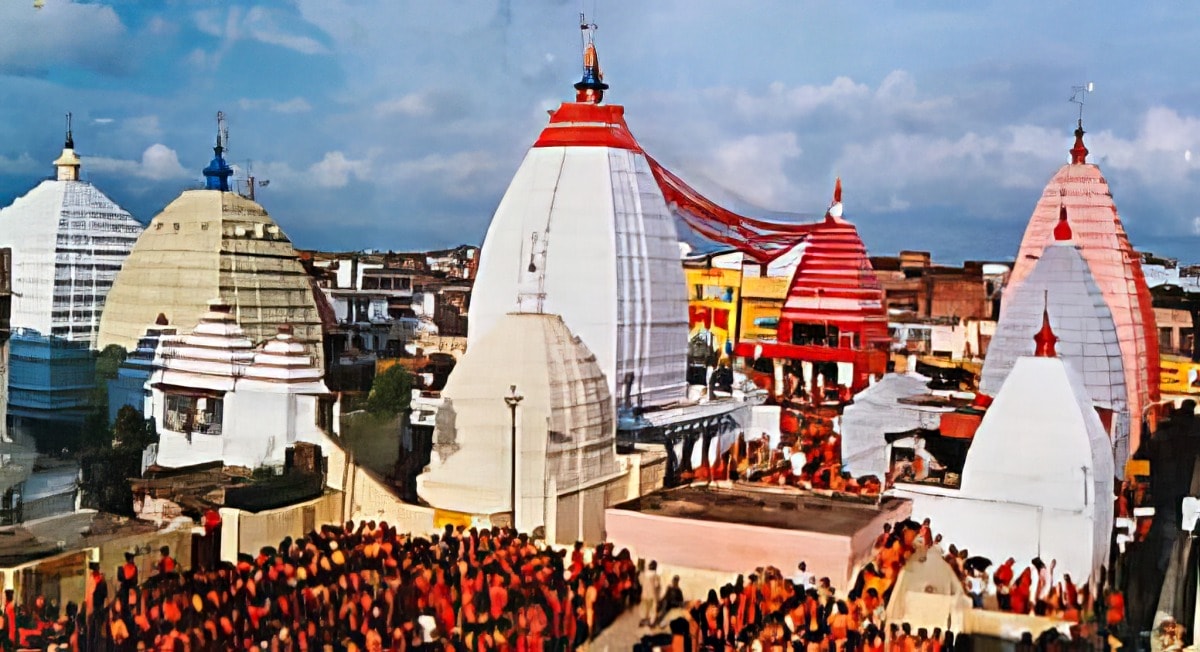
Vaidyanath Jyotirlinga, nestled in Deoghar, Jharkhand, holds a special place among the highly revered jyotirlingas in India. It's not just a temple; it's a beacon of hope and faith for many. The stories that swirl around Vaidyanath are mesmerizing, speaking of devotion, miracles, and the divine. One such tale involves Ravana and his unwavering devotion to Lord Shiva, highlighting the temple's significance in our mythology.
The atmosphere here during the month of Shravana is electrifying, with devotees pouring in from all corners to seek blessings. It's said that visiting Vaidyanath can rid one of all miseries and lead them on the path to salvation. This belief, coupled with the temple's serene surroundings, makes every visit a soul-stirring experience.
Being one of the 52 Shakti Peethas also adds to its spiritual significance. The aura of devotion that envelops the temple, the chants, and the rituals, all create a divine symphony that resonates with anyone who visits. It's a place where the physical meets the spiritual, and one can't help but feel a deeper connection to the divine.
Architecture and History
The architecture of Vaidyanath Jyotirlinga is a blend of ancient grandeur and spiritual essence. The temple, with its majestic spires, stands as a testament to the devotion of countless generations. Each stone and sculpture has a story to tell, making it a living museum of faith and tradition. The historical significance of Vaidyanath is immense, with myths and legends dating back to ancient times, weaving a rich tapestry of cultural heritage.
The history of the temple is intertwined with fascinating tales from Hindu mythology. The story of Ravana and Lord Shiva's shivalinga is particularly intriguing, showcasing the temple's importance in the cosmic scheme. Over the centuries, Vaidyanath has been a witness to the ebb and flow of empires, yet its spiritual flame has never dimmed, attracting devotees from all walks of life.
Temple Timings
The temple welcomes devotees all year round, with the doors opening from 4:00 AM to 3:30 PM, and then again from 6:00 PM to 9:00 PM. The best time to visit is during the early morning Aarti, when the temple is bathed in the serene light of dawn, and the air is filled with devotion. It's a profoundly moving experience, one that stays with you long after you've left.
How To Reach
Reaching Vaidyanath Jyotirlinga is quite convenient. The nearest railway station is Jasidih, from where you can easily get a taxi or a bus to Deoghar. For those coming by air, the nearest airport is in Patna, after which you can take a train or a car to Deoghar. The journey to Vaidyanath is as much a part of the pilgrimage as the destination itself, with each turn of the road bringing you closer to spiritual awakening.
Best Times to Visit
While Vaidyanath Jyotirlinga can be visited throughout the year, the most auspicious time is during the Shravana month. This period sees a massive influx of devotees, all seeking blessings and participating in the sacred rituals. The energy and devotion during this time are palpable, making it a truly unforgettable experience. However, if you prefer a quieter visit, the months of October to March offer pleasant weather and a more serene atmosphere.
7. Mahakaleshwar, Madhya Pradesh - The Lord of Time
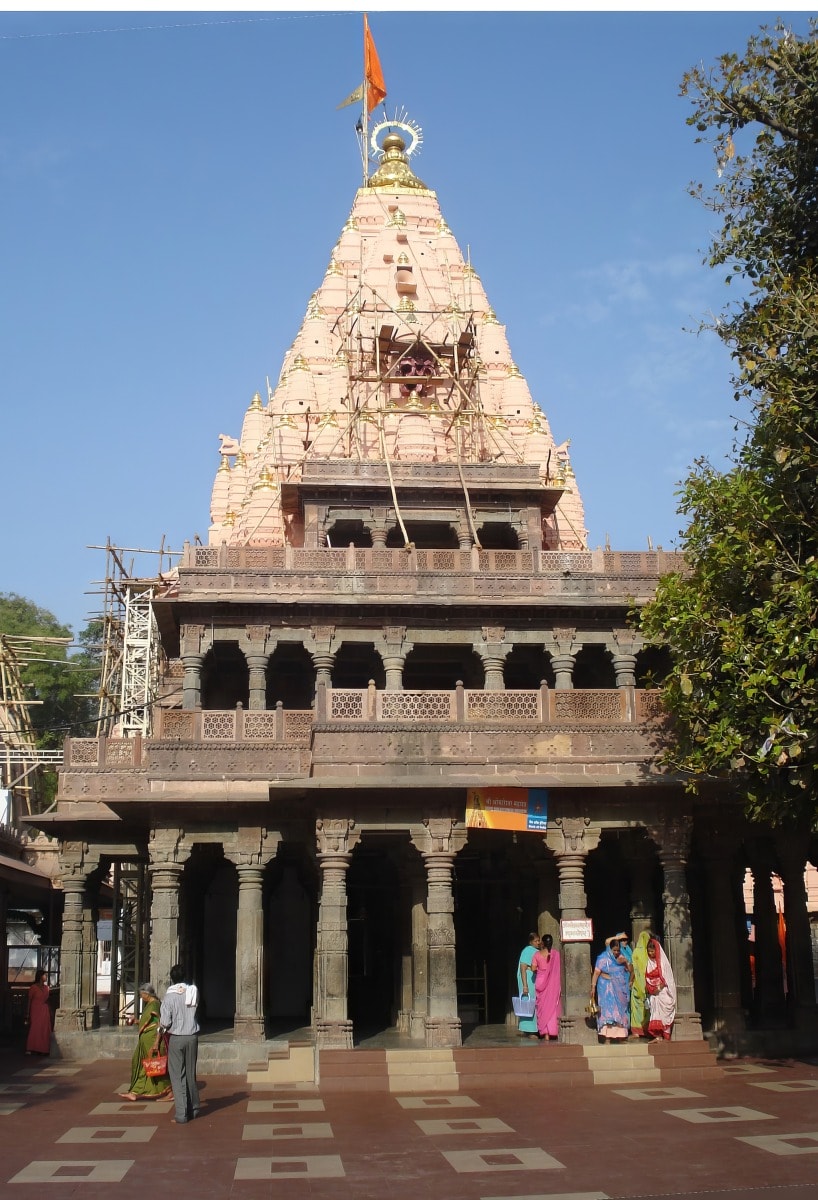
The Mahakaleshwar Temple, standing majestically in Ujjain, Madhya Pradesh, is a place where time seems to stand still. As one of the twelve jyotirlingas, it holds a special place in the hearts of devotees. The temple, located on the banks of the Rudra Sagar lake, is not just a site of worship but a beacon of spirituality, drawing people from all walks of life to seek solace and divine blessings.
The unique Bhasma Aarti, where the deity is anointed with sacred ash, is something that you have to experience at least once in your lifetime. The ritual is a powerful reminder of the impermanence of life and the eternal nature of the soul. It's moments like these that define the spiritual journey at Mahakaleshwar, making every visit a profound experience.
The energy of Mahakaleshwar is indescribable. There's a sense of timelessness that envelops you, a connection to something beyond the material world. It's a place where prayers are whispered, and hopes are renewed. Every corner of the temple tells a story, every ritual a chapter in the spiritual saga that is Mahakaleshwar. It's not just a visit; it's a pilgrimage to the core of one's being.
Architecture and History
The architecture of Mahakaleshwar Temple is a stunning example of ancient Indian craftsmanship. The complex design, the towering spires, and the intricate carvings all speak of a time when devotion was expressed through stone and mortar. The temple stands as a testament to the architectural brilliance of our ancestors, making it a site of historical and cultural significance.
The history of Mahakaleshwar is as rich and varied as the legends that surround it. Standing on the banks of the Rudra Sagar lake, the temple has been a spiritual haven for centuries. Its significance in the Hindu pantheon is unparalleled, with the unique Bhasma Aarti being a highlight that attracts devotees from across the globe. Each visit to Mahakaleshwar is a step back in time, a journey into the heart of India's spiritual heritage.
Mahakaleshwar – Ujjain in Madhya Pradesh - Temple Timings
The temple welcomes devotees from early morning until midnight, offering plenty of opportunities to witness its rituals, including the unique Bhasma Aarti held in the morning. Here's a quick guide to the temple's schedule:
- Bhasma Aarti at 4:00 AM (requires prior registration)
- Temple opens at 5:00 AM
- Midday Aarti at 12:00 PM
- Evening Aarti at 7:00 PM
- Temple closes at Midnight
Best Time to Visit
The best time to visit is from September to March, when Ujjain's weather is most pleasant. This period is especially vibrant during the Mahashivratri festival.
How to Reach
Ujjain is well-connected by road, rail, and air. The nearest airport is in Indore, about 55 kilometers away, from where Ujjain can be reached by road or rail. Ujjain's railway station is a major hub that connects the city to other major cities in India, making access to Mahakaleshwar relatively easy for pilgrims and tourists.
Nearby Tourist Places
Ujjain itself is a city of immense historical and cultural significance, with many attractions related to Hindu mythology and ancient Indian civilization. Sites like the Ram Ghat on the Shipra River, Kal Bhairav Temple, and the Vedha Shala (Observatory) built by Maharaja Jai Singh II, add to the spiritual and cultural experience of visitors to Mahakaleshwar.
8. Omkareshwar, Madhya Pradesh - The Sacred Island
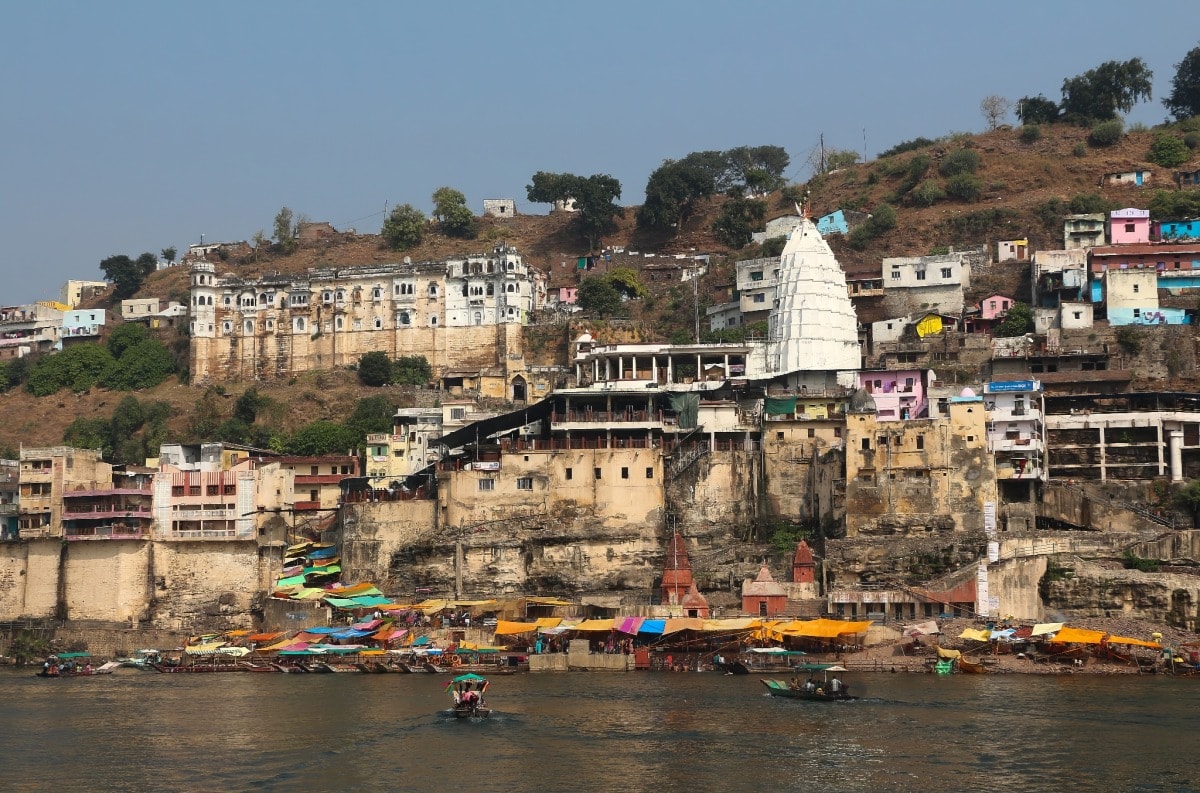
Omkareshwar, nestled on an island shaped like the holy symbol 'Om', is a spiritual haven. This sacred site houses one of the revered 12 Jyotirlingas of Lord Shiva. The serene environment, coupled with the divine energy, makes Omkareshwar a must-visit for anyone on a quest for spiritual enlightenment. The presence of the Narmada River adds to its mystical charm, believed to purify one's soul.
The essence of devotion is palpable as you step onto this island, with chants and prayers echoing in the air. A visit to Omkareshwar offers not just spiritual solace but also a chance to witness the convergence of nature and spirituality. The journey to this divine Jyotirlinga, amidst the serene landscape of Madhya Pradesh, is an experience that stays with you forever.
Architecture and History
The architecture of the Omkareshwar Jyotirlinga temple is a magnificent example of ancient Indian craftsmanship. The intricately carved stone structures and the temple's strategic location at the confluence of the Narmada and Kaveri rivers speak volumes about the ingenuity of its creators. Historically, this temple has been a significant pilgrimage spot, drawing devotees and seekers for centuries.
Legends say that the Jyotirlinga at Omkareshwar appeared naturally, symbolizing the manifestation of Lord Shiva's divine light. The island's 'Om' shape is considered auspicious, attracting pilgrims from across the globe. The temple's serene ambiance, coupled with its rich history, offers a unique blend of spiritual and historical exploration.
Omkareshwar – Khandwa In Madhya Pradesh - Temple Timings
The Omkareshwar Temple is a peaceful place that welcomes visitors from 5:00 AM to 10:00 PM, offering a chance to join in prayer and rituals throughout the day. The main aarti happens at dawn, and you can find out more about special poojas directly at the temple.
Best Time to Visit
The best months to visit are from October to March when the weather is pleasant, perfect for taking part in the temple's spiritual offerings and enjoying the surrounding beauty.
How to Reach
Omkareshwar is well-connected by road and can be accessed from major cities in Madhya Pradesh. The nearest railway station is at Omkareshwar Road (Mortakka) on the Ratlam-Khandwa section of the Western Railways, about 12 kilometers from the temple. The nearest airport is in Indore, approximately 77 kilometers away, making it accessible for national and international visitors.
Nearby Tourist Places
The geography of Omkareshwar, with the holy Narmada River encircling it and the lush landscapes, offers a tranquil retreat for visitors. The serene environment, combined with the spiritual aura, provides a unique blend of peace and devotion. Trekking around the island and exploring the nearby caves and ruins are popular activities for nature lovers and adventure seekers.
9. Kashi Vishwanath, Uttar Pradesh - The Illuminating Beacon
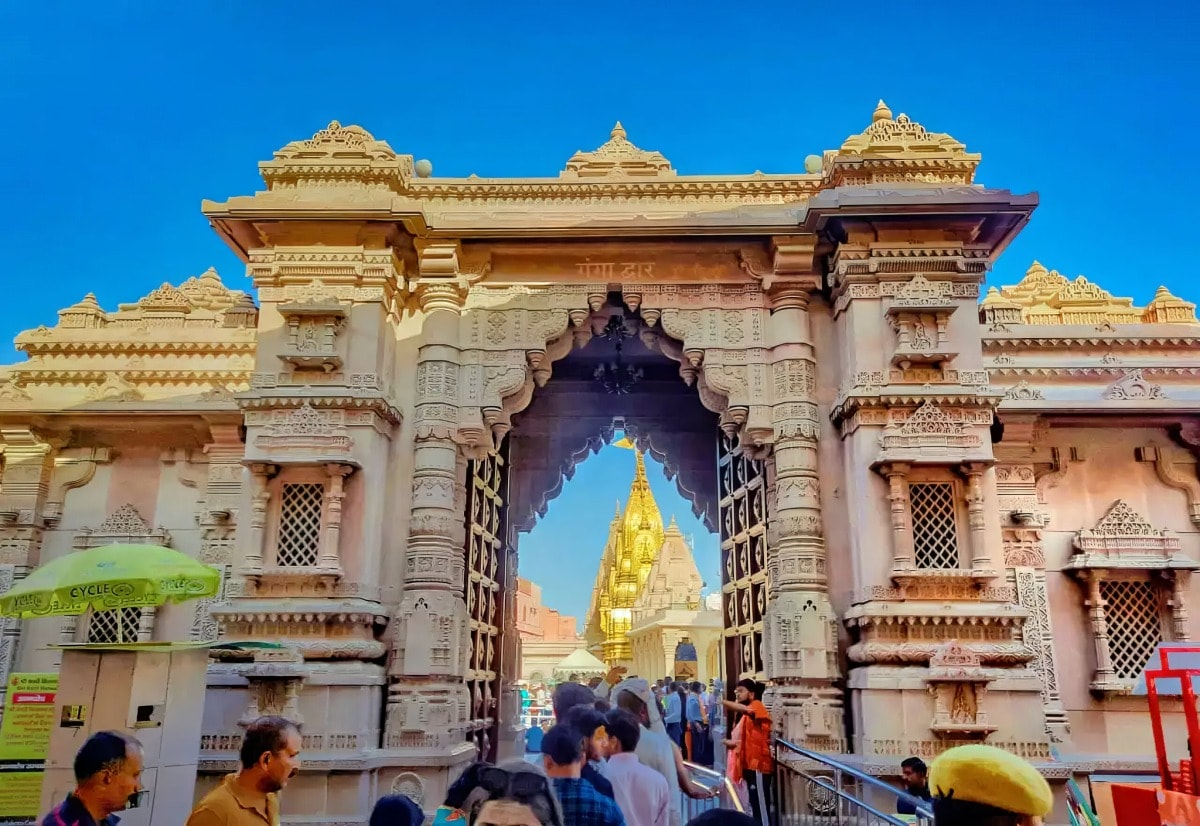
The Kashi Vishwanath Temple, located in the vibrant city of Varanasi, stands as an emblem of faith and eternity. This temple, part of the esteemed 12 Jyotirlingas, holds a special place in the hearts of devotees. Its golden spires, reaching towards the sky, serve as a beacon of divinity, guiding souls towards liberation.
Varanasi, one of the oldest inhabited parts of India, encapsulates the essence of spiritual India. The Kashi Vishwanath Temple, with its rich 18th-century heritage, is a testament to the timeless devotion to Lord Shiva. The temple's location on the western bank of the holy Ganges adds to its sanctity, offering pilgrims a chance to bathe in the sacred waters before seeking blessings.
The experience of visiting the Kashi Vishwanath Temple is unparalleled. The alleyways leading to the temple, lined with vendors offering flowers and offerings, set the stage for a profound spiritual journey. The Ganga Aarti, a ritual of worship performed at dawn and dusk, is a spectacle of light and devotion, leaving an indelible mark on the hearts of those who witness it.
Architecture and History
The Kashi Vishwanath Temple is a masterpiece of Indian architecture, encapsulating centuries of history and devotion. Constructed in the 18th century, it has withstood the tests of time, serving as a spiritual lighthouse for millions. The temple's intricate carvings and golden dome are not just architectural marvels but symbols of the divine light of Lord Shiva.
Over the centuries, the temple has been a witness to the ebb and flow of empires, yet it has retained its sanctity and importance in the spiritual landscape of India. The legends associated with it are numerous, each adding a layer to its mystique. The temple’s reconstruction in the 18th century by Maharani Ahilyabai Holkar marks a significant chapter in its history, symbolizing the resurgence of Hindu culture and spirituality.
Temple Timings
The Kashi Vishwanath Temple opens its doors to devotees from 3:00 AM, offering various rituals and aartis throughout the day until 11:00 PM. The temple schedules special aartis at dawn and dusk, which are a must-see for their spiritual vibrancy and the breathtaking spectacle of lights and chants.
How To Reach
Reaching Varanasi, and consequently the Kashi Vishwanath Temple, is convenient from various parts of India. Varanasi is well-connected by air, with the Lal Bahadur Shastri International Airport located about 25 km from the temple. Train services link Varanasi to major Indian cities, and the temple is easily accessible from the Varanasi railway station. For those driving, the city’s extensive road network ensures a smooth journey.
Best Times to Visit
The ideal time to visit the Kashi Vishwanath Temple is from November to February. During these months, the weather in Varanasi is cool and pleasant, making your visit more comfortable. The spiritual fervor of festivals like Shivratri, celebrated with great enthusiasm here, offers a deeper insight into the cultural and religious fabric of this ancient city.
Nearby Tourist Places
After visiting the Kedarnath Temple, there's a lot more to explore nearby. Vasuki Tal is a serene lake just 8km away, offering breathtaking views of the Himalayas. Another gem is the Sonprayag, known for its confluence of two holy rivers. For those interested in history, the ancient Triyuginarayan Temple, believed to be the wedding site of Lord Shiva and Goddess Parvati, is a must-visit. These places not only add to the spiritual journey but also let you embrace the natural beauty and historical richness of Uttarakhand.
10. Kedarnath, Uttarakhand - The Eternal Abode
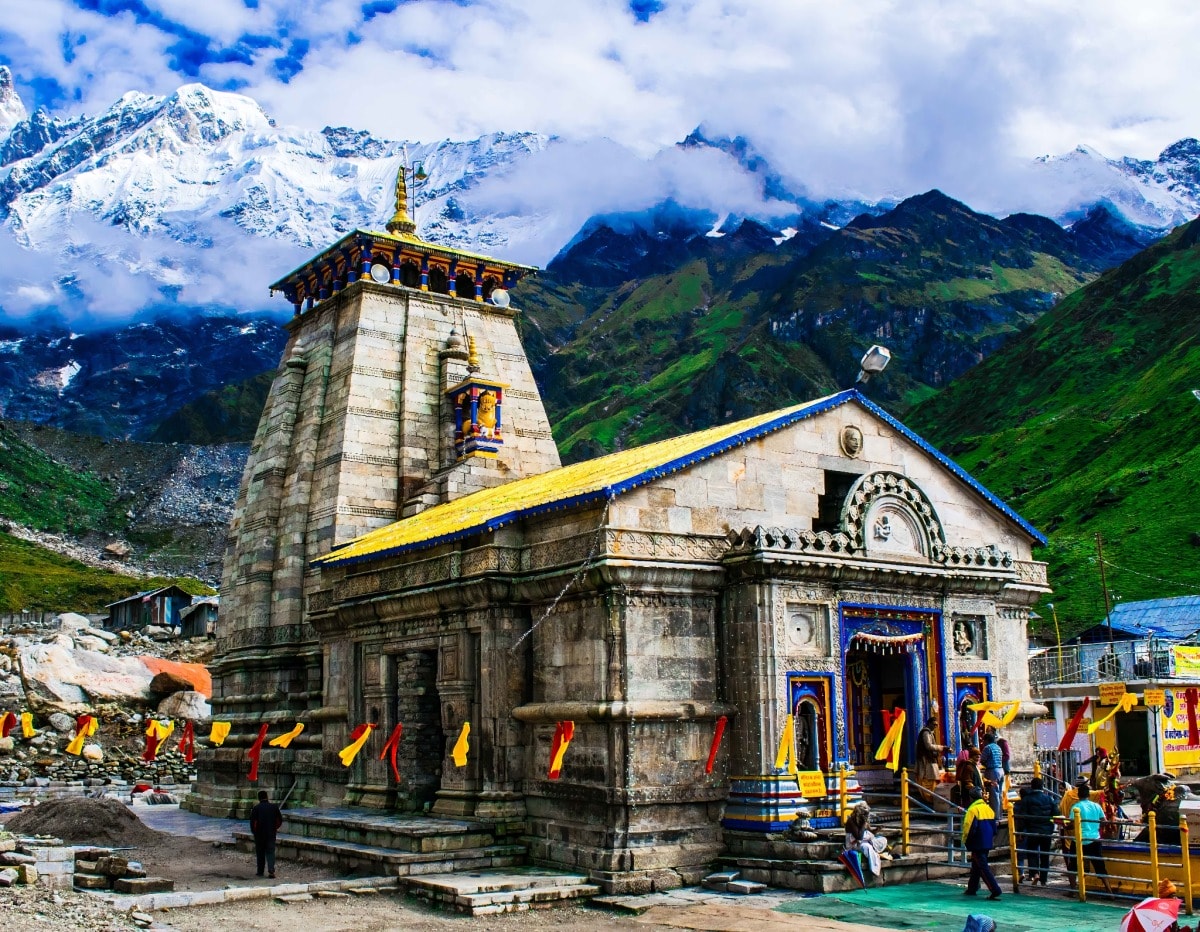
Kedarnath, nestled in the snow-clad Himalayas, is not just a temple but a beacon of hope and faith for many. My journey here was filled with anticipation and reverence. This sacred site, part of the Char Dham Yatra, is home to one of the twelve Jyotirlingas of Lord Shiva in India. The Kedarnath Jyotirlinga, set against the backdrop of majestic mountains, offers an unparalleled spiritual experience. The air here carries a sense of peace that calms the soul.
The legend of Kedarnath is as fascinating as the place itself. It's said that Lord Shiva, the destroyer and transformer, manifested as a Jyotirlinga here, making it a crucial site for Shiva worshippers. The journey to Kedarnath is as significant as the destination, involving a trek that tests one's endurance and faith. Yet, the sight of the temple, standing resilient amid harsh weather conditions, reassures every pilgrim of the divine presence.
Being part of the Char Dham Yatra, Kedarnath holds a special place in the hearts of the devout. The yatra, encompassing four sacred sites, is considered a journey of a lifetime, promising salvation and divine blessings. Kedarnath, with its divine ambiance and historical significance, remains one of the most revered temples in India, drawing pilgrims from across the globe.
Architecture and History
The architecture of the Kedarnath Temple is a marvel in itself, built with massive stone slabs over a large rectangular platform. Ancient scriptures say that the Pandavas constructed the original temple, and Adi Shankaracharya later revived it. The temple survived many calamities, standing as a testament to the enduring human spirit.
Inside, the sanctum houses the conical-shaped Jyotirlinga, embodying Lord Shiva's mysterious and formless aspect. The walls and pillars are adorned with intricate carvings that narrate tales from ancient lore, adding to the temple's mystical aura. This architectural masterpiece, set amidst the rugged Himalayan landscape, is a sight to behold, blending spirituality with natural beauty.
Temple Timings
The Kedarnath Temple welcomes pilgrims from 4 AM to 12 Noon and then from 3 PM to 9 PM. These timings allow devotees to partake in the morning and evening rituals, offering prayers and seeking blessings. It's a beautiful experience, attending the aarti and immersing oneself in the divine energy that pervades this ancient shrine.
How To Reach
Reaching Kedarnath is an adventure. The nearest airport is Jolly Grant in Dehradun, and the closest railway station is in Rishikesh. From there, one can take a bus or taxi to Gaurikund, the trek's starting point. The trek to Kedarnath is about 16km, a journey that is both challenging and fulfilling, surrounded by breathtaking views.
Best Times to Visit
The best time to visit Kedarnath is from May to June and then from September to October. The temple remains closed during the winter months due to heavy snowfall. The pleasant weather during these months makes the journey easier, allowing pilgrims to enjoy the spiritual and natural beauty of the place.
11. Rameshwar, Tamil Nadu - The Southernmost Light
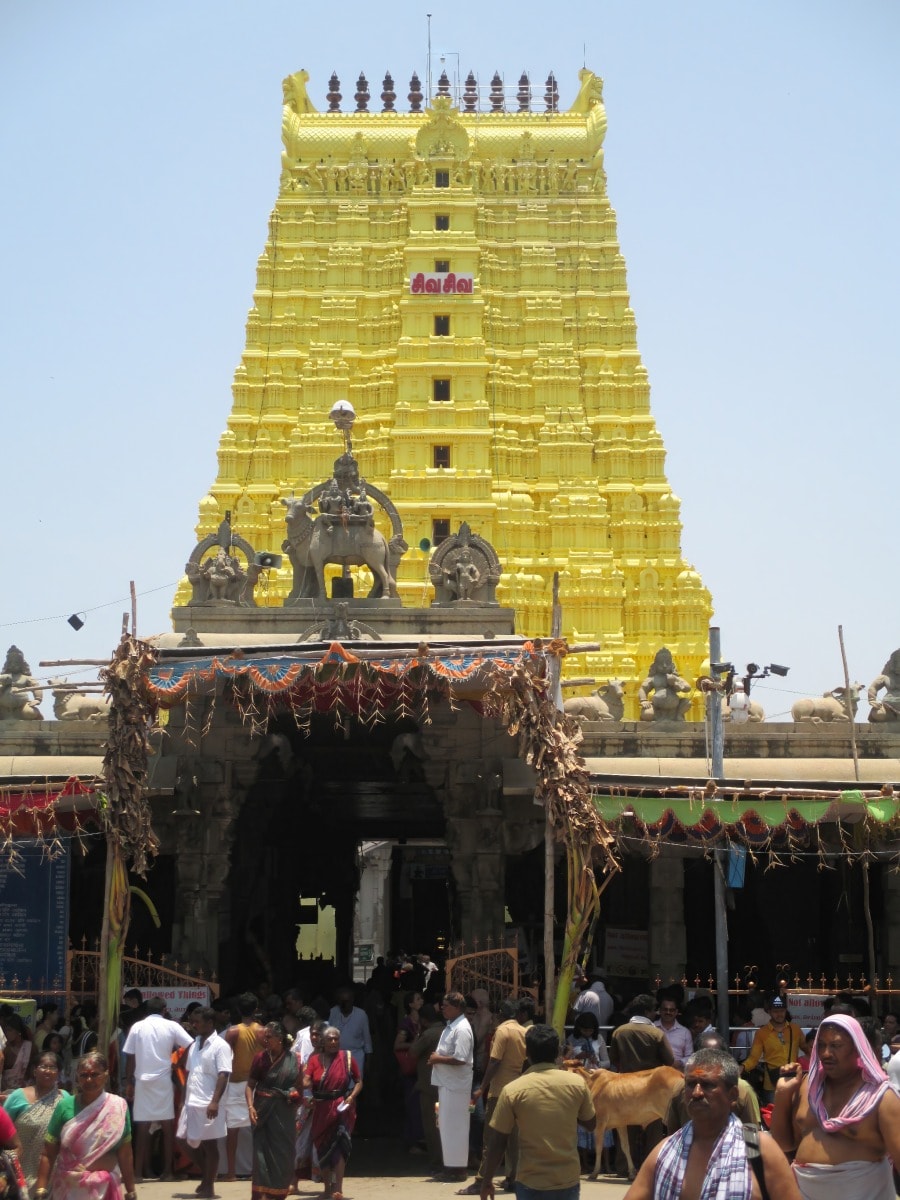
Rameshwar, or the Ramanathaswamy Temple, is a spiritual beacon in Tamil Nadu, drawing devotees to its sacred shores. This temple, part of the Char Dham, holds the essence of devotion and mythology, making it a pivotal pilgrimage site. The Ramanathaswamy Temple, dedicated to Lord Shiva, is where Lord Rama is believed to have prayed before his journey to Lanka. The energy here is palpable, blending devotion with the tranquility of the ocean.
The temple's corridors, long and ornate, hold the whispers of centuries, echoing tales of faith and miracles. The architectural grandeur of Ramanathaswamy is unmatched, with its sprawling corridors being the longest among Hindu temples. This place is not just about worship but about experiencing a profound connection with the divine. The twelve Jyotirlingas of Lord Shiva in India each tell a story, and Rameshwar adds its unique chapter, rich in legend and spirituality.
Visiting Rameshwar feels like stepping into a different realm, where time slows down, and the mundane fades away. The temple, with its serene ambiance and sacred waters, offers a sanctuary for those seeking peace and introspection. It's a journey that stays with you, long after you've left its shores, calling you back to its sacred light.
Architecture and History
The Ramanathaswamy Temple is an architectural marvel, showcasing the brilliance of Dravidian architecture. Its sprawling corridors, adorned with intricately carved pillars, lead devotees through a maze of beauty and devotion. The temple's history is intertwined with the epic Ramayana, making it a site of immense cultural and spiritual significance.
At the heart of the temple, the sanctum sanctorum houses the Shivalinga, believed to have been consecrated by Lord Rama himself. The temple complex is a testament to the devotion of generations, with structures that have stood the test of time, offering a glimpse into the past's spiritual heritage.
Temple Timings
The Ramanathaswamy Temple opens its doors to devotees from 5:00 AM, welcoming them to partake in the morning rituals. The temple remains open throughout the day, closing after the evening aarti. These timings provide ample opportunity for visitors to explore the temple's spiritual and architectural wonders.
How To Reach
Reaching Rameshwar is straightforward, with the closest airport in Madurai, about 174km away. The Rameswaram railway station is well-connected, making it accessible from various parts of India. For those preferring the road, buses and taxis frequently ply to Rameswaram, offering a comfortable journey.
Best Times to Visit
The ideal time to visit Rameshwar is between October and April, when the weather is pleasant, making it conducive for temple visits and exploring the island. This period avoids the heavy monsoon rains and the peak summer heat, ensuring a comfortable pilgrimage experience.
12. Mallikarjuna, Andhra Pradesh - The Mountain Shrine
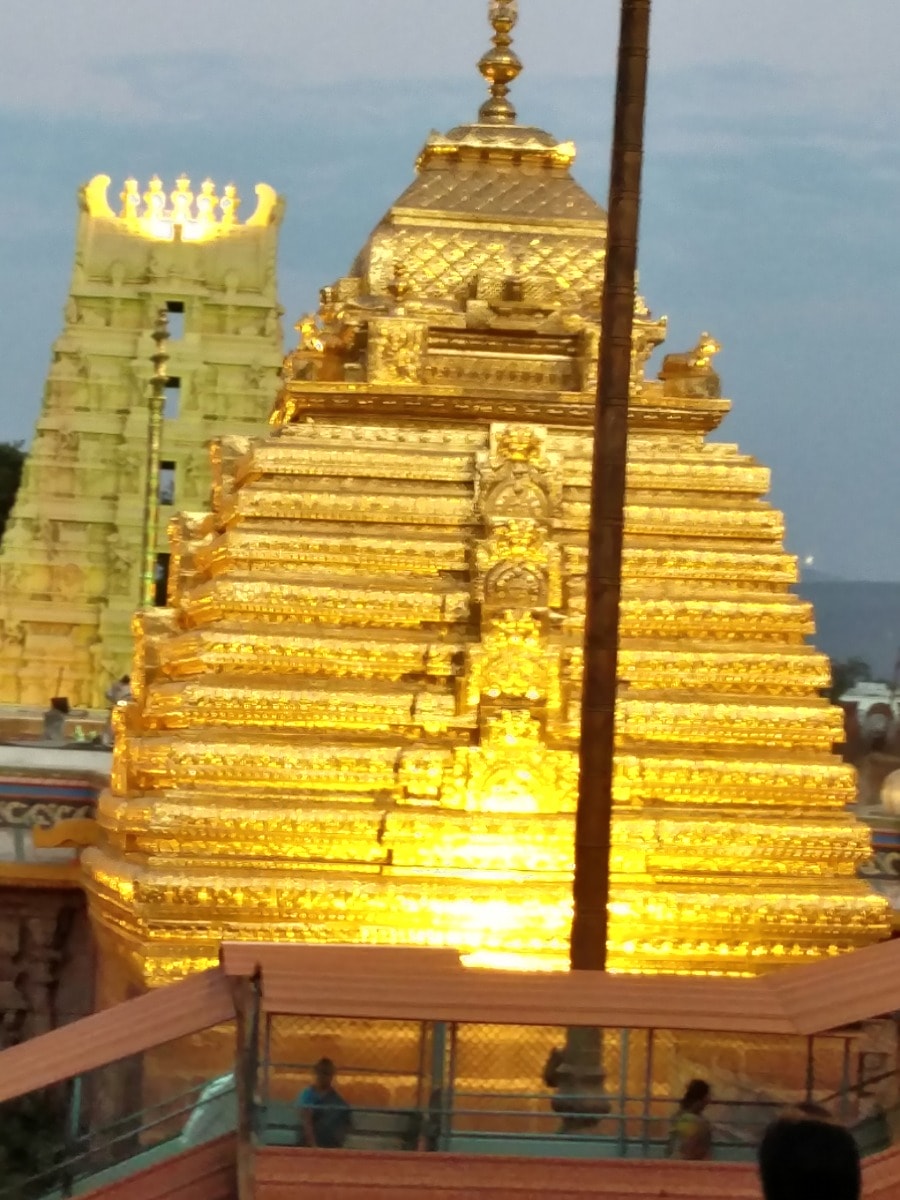
Mallikarjuna, perched atop the Shri Saila Mountain, is a divine sanctuary where spirituality meets nature. Among the 12 Jyotirlingas in India, this temple holds a special place, often referred to as the Kailash of the South. My visit here was a journey of discovery, where every stone and every turn told a story of devotion and divine energy.
The temple, with its majestic architecture and spiritual ambiance, offers a unique experience. The Mallikarjuna Jyotirlinga, dedicated to Lord Shiva, is a beacon of hope and faith for countless devotees. The serene environment, coupled with the temple's rich history, provides a perfect setting for meditation and prayer. It's a place where one can truly connect with the divine, seeking blessings and inner peace.
The significance of Mallikarjuna extends beyond its religious aspects, embodying a cultural heritage that has been preserved over centuries. The temple's location, on the banks of the River Krishna, adds to its mystical charm, making it a must-visit for anyone on a spiritual quest. It's not just a temple but a journey into the heart of devotion, offering a glimpse into the profound depths of Hindu spirituality.
Architecture and History
The architecture of the Mallikarjuna Temple is a testament to the artistic and spiritual heritage of Andhra Pradesh. The temple's intricate carvings and majestic gopurams (towers) are a visual treat, showcasing the craftsmanship of ancient artisans. The temple complex, with its mukha mandapa (hall) and sanctum sanctorum, reflects the Dravidian architectural style, inviting devotees into a world of divine beauty.
Historically, Mallikarjuna is not just a temple but a chronicle of devotion through the ages. It stands as one of the 12 Jyotirlinga in India, each with its own tale. The temple's lore is intertwined with that of Lord Shiva and Goddess Parvati, making it a site of unparalleled spiritual significance. Its enduring legacy continues to attract pilgrims from across the globe, seeking solace and enlightenment.
Temple Timings
Visiting a Jyotirlinga is a special experience. Let me tell you about the temple timings. Usually, they're open from early morning to late evening. This gives everyone a chance to visit, whether you're an early bird or like to explore in the evening. It's best to check the specific timings of the temple you plan to visit, as they can vary.
How To Reach
Getting to these sacred temples is part of the adventure. Most of the Jyotirlingas are well-connected by road and rail. For some, you might need to take a bus or hire a cab from the nearest city or town. A few are even accessible by air, with the nearest airport a drive away. It's amazing how well connected these places are, making the journey easier for everyone.
Best Times to Visit
Wondering when to visit? The best time is usually between October and March. The weather is cooler, making the journey more comfortable. Plus, during these months, you might get to see some special festivals. It's a great way to experience the local culture and the spiritual vibes of the place. Each temple has its unique festivals, so you might want to plan your visit around them.
Nearby Tourist Places
Around these temples, there are often lots of interesting places to explore. From beautiful beaches and serene lakes to historic forts and peaceful gardens. It's great to combine a spiritual journey with some sightseeing. Make sure to check out what's nearby the temple you're visiting. You might find some hidden gems that'll make your trip even more memorable.
The Divine Experiences Along the Way
My journey through the 12 Jyotirlingas in India has been nothing short of magical. Each temple brought a sense of peace and connection I hadn't felt before. It's not just about the temples themselves, but the journey between them. Travelling through India's diverse landscapes, meeting different people, and experiencing the rich culture has been incredibly enriching.
I've heard stories of miracles and spiritual awakenings from fellow travellers. These tales add a layer of mystique and wonder to the journey. Whether it's the calming presence felt in the temples or the inexplicable feeling of being watched over, the experiences along the way have deepened my spiritual understanding and connection.
Personal Accounts of Spiritual Awakenings
I remember speaking to a fellow traveller who shared their story of spiritual awakening. They told me about how visiting the Grishneshwar Jyotirlinga transformed their outlook on life. It was as if they had found a missing piece of themselves. This story, among others, has shown me that these sacred places hold a power beyond our understanding, capable of touching and transforming lives.
Miracles Witnessed by Devotees
On my journey, I've been amazed by the stories of miracles at these sacred sites. People speak of healing, of prayers answered, and of a profound sense of peace encountered. It's humbling to hear how a visit to a Jyotirlinga can have such a profound impact on someone's life. These stories are a testament to the spiritual energy and power these places hold.
In Conclusion: The Eternal Call of the Divine
Reflecting on my journey to the 12 Jyotirlingas in India, I feel a deep sense of gratitude. These sacred sites are not just about the divine presence of Lord Shiva; they're about the journey, the people, and the land that houses them. Each temple, with its unique vibe and story, has contributed to an unforgettable spiritual adventure.
India, with its spiritual richness, offers a unique opportunity to explore one's faith and spirituality. The journey through the Jyotirlingas is more than a religious pilgrimage; it's a path to self-discovery and understanding the divine. I encourage everyone to embark on this journey, with an open heart and mind, to experience the eternal call of the divine.
Reflections on the Spiritual Journey Through the 12 Jyotirlingas
As I travelled from one Jyotirlinga to another, I couldn't help but feel a sense of awe at the spiritual tapestry of India. Each site, from the serene banks of the River Ganges at Kashi Vishwanath to the majestic mountains housing Kedarnath, tells a story of faith, devotion, and the eternal search for the divine. This journey isn't just about seeing the temples; it's about experiencing the presence of Lord Shiva in every stone, every ritual, and in the hearts of the devotees.
The spiritual journey through these sacred sites is a reminder of the power of faith and the divine energy that pervades our world. Whether it's the tranquillity of Omkareshwar in Madhya Pradesh or the solemn grandeur of the Grishneshwar Jyotirlinga, each visit brought me closer to understanding the myriad manifestations of Shiva. This journey has been a profound reminder of the auspicious and holy nature of these sacred places, and the transformative power of faith.
Frequently Asked Questions
Many people ask if it's safe to visit these spiritual sites amidst the ongoing pandemic. I'd say, with proper precautions, it is. Always check the latest travel advisories and health measures. Another common question is about the 12 Jyotirlingas in India. These sacred sites are spread across India, each offering a unique glimpse into the divine. If you're planning a visit, remember, it's not just about reaching the destination, but also about embracing the journey and the spiritual experiences it brings.
The Most Visited Jyotirlingas and Why
Among the 12 Jyotirlingas, Rameshwaram and Kashi Vishwanath are particularly popular. Rameshwaram, with its stunning Dravidian architecture and the holy waters, attracts devotees seeking purification. Kashi Vishwanath, on the banks of the River Ganges, draws pilgrims with its rich history and spiritual significance. Both places offer a profound sense of peace and a tangible connection to the divine, making them must-visit sites for spiritual seekers.
The beauty of these sites is that they offer more than just a religious experience. They are centers of culture, history, and natural beauty, inviting visitors to immerse themselves in the spiritual essence of India. Whether it's the serene waters surrounding Rameshwaram or the bustling streets of Varanasi, each Jyotirlinga has a unique charm, inviting devotees and tourists alike to explore and experience.
How to Prepare for a Jyotirlinga Yatra
Preparing for a journey to the 12 Jyotirlingas involves more than just packing your bags. It's about preparing your mind and spirit for the journey ahead. Start by researching each site, understanding its history, and the best times to visit. Ensure you respect the local customs and traditions. A spiritual journey like this is also an inner journey. Take time to meditate or reflect, especially by the serene River Godavari at Trimbakeshwar or the tranquil surroundings of Omkareshwar in Madhya Pradesh.
Physically, pack light but don't forget essentials like comfortable clothing, medicines, and items for worship. Remember, each temple is dedicated to Lord Shiva, and offering your respect and devotion is key. Embrace the journey with an open heart, and let the divine experiences unfold. The Jyotirlinga Yatra is not just about visiting temples; it's about connecting with the divine and discovering a deeper sense of self amidst the sacred landscapes of India.
What are the 12 Jyotirlinga?
The 12 Jyotirlinga are sacred shrines dedicated to Lord Shiva, where he is worshipped in the form of a Jyotirlingam, or a "pillar of light." These temples hold immense spiritual significance and are spread across India, serving as major pilgrimage sites for Hindus.
Why is the 12 Jyotirlinga darshan so significant?
The darshan (sighting) of the 12 Jyotirlinga is very important because each one represents a different way that Lord Shiva appears. People go on this pilgrimage to receive blessings, get rid of their sins, and reach moksha (a state of freedom).
Can you provide the names and locations of the 12 Jyotirlinga temples?
Absolutely. Here is a list with names and their respective locations:
- Somnath, Gujarat
- Mallikarjuna, Andhra Pradesh
- Mahakaleshwar, Madhya Pradesh
- Omkareshwar, Madhya Pradesh
- Kedarnath, Uttarakhand
- Bhimashankar, Maharashtra
- Kashi Vishwanath, Uttar Pradesh
- Trimbakeshwar, Maharashtra
- Vaidyanath, Jharkhand
- Nageshwar, Gujarat
- Rameshwaram, Tamil Nadu
- Grishneshwar, Maharashtra
What is the best time to embark on a 12 Jyotirlinga tour?
While it depends on the specific temple and its climatic conditions, generally, the period between October and March is considered ideal for a 12 Jyotirlinga tour due to the pleasant weather across most parts of India.
How can I plan my travel for the 12 Jyotirlinga yatra?
When planning a trip to visit the 12 Jyotirlingas, you need to think about things like when the temples are open, the best time of year to go, how to get there, and where to stay. Lots of people choose to go on organized tours that visit all the Jyotirlingas so they don't have to worry about any problems and can focus on their spiritual journey.
Are there any specific rituals or customs to follow at Jyotirlinga temples?
Yes, each Jyotirlinga temple has its own set of rituals and customs. Common practices include Abhishekam (ritual bathing of the Jyotirlinga), Aarti (light ceremony), offering of Prasad (sacred food), and reciting prayers or mantras dedicated to Lord Shiva.
What is the historical importance of these ancient Shiva temples?
Each Jyotirlinga temple has a rich history often linked to ancient legends and Hindu scriptures. They not only represent the divine power of Lord Shiva but also reflect the architectural and cultural heritage of their respective eras and regions in India.
Is there a particular sequence to follow while visiting the 12 Jyotirlinga temples?
There is no mandatory sequence to follow. However, pilgrims may plan their journey based on geographic convenience, beginning with the nearest Jyotirlinga and then moving to others. Some start their pilgrimage from the Somnath temple in Gujarat, due to its prominence.
What should I pack for the 12 Jyotirlinga Yatra?
easier, here are some things you should pack:
- Clothes that are light and cover your knees and shoulders
- A shawl or scarf to cover your head in the temples
- Good walking shoes
- Important documents like IDs and travel papers
- Any medicines you need
- A first-aid kit
- A water bottle
- Toiletries like sunscreen and bug spray
- Money and cards for spending
- Items for worship like a small plate, flowers, and water pot
Remember to research the weather and plan for laundry and electronics. It's also a good idea to get travel insurance And its advised to plan your trip reputated 12 Jyotirlinga yatra travel organiser.
Is it possible to visit all 12 Jyotirlinga in one trip?
Yes, it's possible, though it requires meticulous planning and might be physically demanding. A well-structured 12 Jyotirlinga tour package can help manage the logistics of visiting all 12 temples in a single trip.

Bhetaludu has fresh tech news and cool travel tales. He covers gadgets and faraway places. His blog is for tech fans and those who love to explore.


